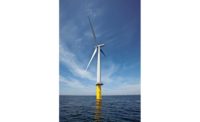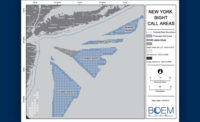New York and New Jersey made big moves last month toward becoming the hub of East Coast offshore wind-energy development, announcing solicitations for thousands of added megawatt capacity and new infrastructure.
Virginia also wants to be a player, completed construction of a prototype wind farm to propel its plan to add 2,600 MW of offshore wind power to its electricity supply.
New York issued on July 21 an accelerated solicitation for 2,500 MW of offshore wind, coupled with funding to develop multiple ports, as well as 1,500 MW of onshore wind, solar power and battery storage that includes a process to identify build-ready sites for large-scale renewable development.
The state wants offshore wind bids by Oct. 20, with contracts set for award by Dec. 31, far shorter than the usual year-long process. Bids will be accepted for projects of between 400 MW and 2,500 MW. New York’s goal is to have 9,000 MW installed offshore by 2035. A previous solicitation netted 1,700 MW of accepted projects.
New Jersey said last month it is considering up to 2,400 MW of offshore wind energy in an aggressive followup solititation to last year, when it awarded an 1,100-MW project to Danish developer Orsted that awaits construction permits for a planned startup by 2024. “Using lessons learned from our first successful solicitation, we are very excited to move forward with our second,” said state utilities board President Joseph L. Fiordaliso.
The state, which aims to develop 7,500 MW of offshore wind by 2035, said project bids are due in December, with a final board decision in June 2021.
Investment in U.S. offshore wind is projected at $78 billion by 2030, with 20 projects awaiting approvals.
The first wind turbines in U.S. federal waters were completed in late June off the coast of Virginia—a two-turbine, 12-MW pilot project that will inform developer-utility Dominion Energy on permitting, design, installation and operations for its proposed record 2,600-MW commercial project, set to begin construction in 2024.
“Clean-energy jobs have the potential to serve as a catalyst to re-ignite the economy following the impacts of the pandemic,” said firm CEO Thomas Farrell. A new law in Virginia requires 5,200 MW of offshore wind by 2034.
But the U.S. commercial-scale effort closest to final approval is the 800-MW Vineyard Wind farm off the coast of Massachusetts.
The U.S. Interior Dept. said it will decide whether to approve the farm in December, noting more than 77,000 comments received on a draft supplemental environmental review released in June. That unexpected extra scrutiny has set back the project's planned construction start this year, in requiring its developer to submit added impact details for nearly 22 GW of planned East Coast wind energy project wanted by fishing interests that oppose wind-turbine arrays.
Interior Secretary David Bernhardt, who delayed the Vineyard Wind approval, met with fisheries advocates on July 21 and also will confer with Massachusetts Gov. Charlie Baker on the project. A state energy department spokesman did not respond to a request for comment.






Post a comment to this article
Report Abusive Comment